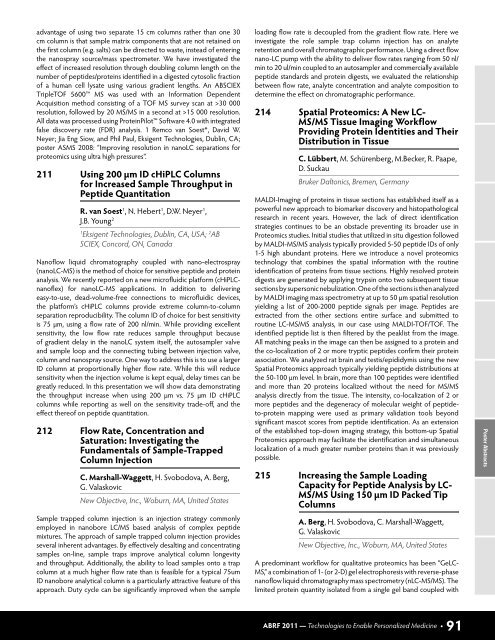Conference Program - ABRF 2011 - Association of Biomolecular ...
Conference Program - ABRF 2011 - Association of Biomolecular ...
Conference Program - ABRF 2011 - Association of Biomolecular ...
- No tags were found...
You also want an ePaper? Increase the reach of your titles
YUMPU automatically turns print PDFs into web optimized ePapers that Google loves.
advantage <strong>of</strong> using two separate 15 cm columns rather than one 30cm column is that sample matrix components that are not retained onthe first column (e.g. salts) can be directed to waste, instead <strong>of</strong> enteringthe nanospray source/mass spectrometer. We have investigated theeffect <strong>of</strong> increased resolution through doubling column length on thenumber <strong>of</strong> peptides/proteins identified in a digested cytosolic fraction<strong>of</strong> a human cell lysate using various gradient lengths. An ABSCIEXTripleTOF 5600 MS was used with an Information DependentAcquisition method consisting <strong>of</strong> a TOF MS survey scan at >30 000resolution, followed by 20 MS/MS in a second at >15 000 resolution.All data was processed using ProteinPilot S<strong>of</strong>tware 4.0 with integratedfalse discovery rate (FDR) analysis. 1 Remco van Soest*, David W.Neyer; Jia Eng Siow, and Phil Paul, Eksigent Technologies, Dublin, CA;poster ASMS 2008: “Improving resolution in nanoLC separations forproteomics using ultra high pressures”.211 Using 200 µm ID cHiPLC Columnsfor Increased Sample Throughput inPeptide QuantitationR. van Soest 1 , N. Hebert 1 , D.W. Neyer 1 ,J.B. Young 21Eksigent Technologies, Dublin, CA, USA; 2 ABSCIEX, Concord, ON, CanadaNan<strong>of</strong>low liquid chromatography coupled with nano-electrospray(nanoLC-MS) is the method <strong>of</strong> choice for sensitive peptide and proteinanalysis. We recently reported on a new micr<strong>of</strong>luidic platform (cHiPLCnan<strong>of</strong>lex)for nanoLC-MS applications. In addition to deliveringeasy-to-use, dead-volume-free connections to micr<strong>of</strong>luidic devices,the platform’s cHiPLC columns provide extreme column-to-columnseparation reproducibility. The column ID <strong>of</strong> choice for best sensitivityis 75 µm, using a flow rate <strong>of</strong> 200 nl/min. While providing excellentsensitivity, the low flow rate reduces sample throughput because<strong>of</strong> gradient delay in the nanoLC system itself, the autosampler valveand sample loop and the connecting tubing between injection valve,column and nanospray source. One way to address this is to use a largerID column at proportionally higher flow rate. While this will reducesensitivity when the injection volume is kept equal, delay times can begreatly reduced. In this presentation we will show data demonstratingthe throughput increase when using 200 µm vs. 75 µm ID cHiPLCcolumns while reporting as well on the sensitivity trade-<strong>of</strong>f, and theeffect there<strong>of</strong> on peptide quantitation.212 Flow Rate, Concentration andSaturation: Investigating theFundamentals <strong>of</strong> Sample-TrappedColumn InjectionC. Marshall-Waggett, H. Svobodova, A. Berg,G. ValaskovicNew Objective, Inc., Woburn, MA, United StatesSample trapped column injection is an injection strategy commonlyemployed in nanobore LC/MS based analysis <strong>of</strong> complex peptidemixtures. The approach <strong>of</strong> sample trapped column injection providesseveral inherent advantages. By effectively desalting and concentratingsamples on-line, sample traps improve analytical column longevityand throughput. Additionally, the ability to load samples onto a trapcolumn at a much higher flow rate than is feasible for a typical 75umID nanobore analytical column is a particularly attractive feature <strong>of</strong> thisapproach. Duty cycle can be significantly improved when the sampleloading flow rate is decoupled from the gradient flow rate. Here weinvestigate the role sample trap column injection has on analyteretention and overall chromatographic performance. Using a direct flownano-LC pump with the ability to deliver flow rates ranging from 50 nl/min to 20 ul/min coupled to an autosampler and commercially availablepeptide standards and protein digests, we evaluated the relationshipbetween flow rate, analyte concentration and analyte composition todetermine the effect on chromatographic performance.214 Spatial Proteomics: A New LC-MS/MS Tissue Imaging WorkflowProviding Protein Identities and TheirDistribution in TissueC. Lübbert, M. Schürenberg, M.Becker, R. Paape,D. SuckauBruker Daltonics, Bremen, GermanyMALDI-Imaging <strong>of</strong> proteins in tissue sections has established itself as apowerful new approach to biomarker discovery and histopathologicalresearch in recent years. However, the lack <strong>of</strong> direct identificationstrategies continues to be an obstacle preventing its broader use inProteomics studies. Initial studies that utilized in situ digestion followedby MALDI-MS/MS analysis typically provided 5-50 peptide IDs <strong>of</strong> only1-5 high abundant proteins. Here we introduce a novel proteomicstechnology that combines the spatial information with the routineidentification <strong>of</strong> proteins from tissue sections. Highly resolved proteindigests are generated by applying trypsin onto two subsequent tissuesections by supersonic nebulization. One <strong>of</strong> the sections is then analyzedby MALDI imaging mass spectrometry at up to 50 µm spatial resolutionyielding a list <strong>of</strong> 200-2000 peptide signals per image. Peptides areextracted from the other sections entire surface and submitted toroutine LC-MS/MS analysis, in our case using MALDI-TOF/TOF. Theidentified peptide list is then filtered by the peaklist from the image.All matching peaks in the image can then be assigned to a protein andthe co-localization <strong>of</strong> 2 or more tryptic peptides confirm their proteinassociation. We analyzed rat brain and testis/epididymis using the newSpatial Proteomics approach typically yielding peptide distributions atthe 50-100 µm level. In brain, more than 100 peptides were identifiedand more than 20 proteins localized without the need for MS/MSanalysis directly from the tissue. The intensity, co-localization <strong>of</strong> 2 ormore peptides and the degeneracy <strong>of</strong> molecular weight <strong>of</strong> peptideto-proteinmapping were used as primary validation tools beyondsignificant mascot scores from peptide identification. As an extension<strong>of</strong> the established top-down imaging strategy, this bottom-up SpatialProteomics approach may facilitate the identification and simultaneouslocalization <strong>of</strong> a much greater number proteins than it was previouslypossible.215 Increasing the Sample LoadingCapacity for Peptide Analysis by LC-MS/MS Using 150 µm ID Packed TipColumnsA. Berg, H. Svobodova, C. Marshall-Waggett,G. ValaskovicNew Objective, Inc., Woburn, MA, United StatesA predominant workflow for qualitative proteomics has been “GeLC-MS,” a combination <strong>of</strong> 1- (or 2-D) gel electrophoresis with reverse-phasenan<strong>of</strong>low liquid chromatography mass spectrometry (nLC-MS/MS). Thelimited protein quantity isolated from a single gel band coupled withPoster Abstracts<strong>ABRF</strong> <strong>2011</strong> — Technologies to Enable Personalized Medicine • 91


